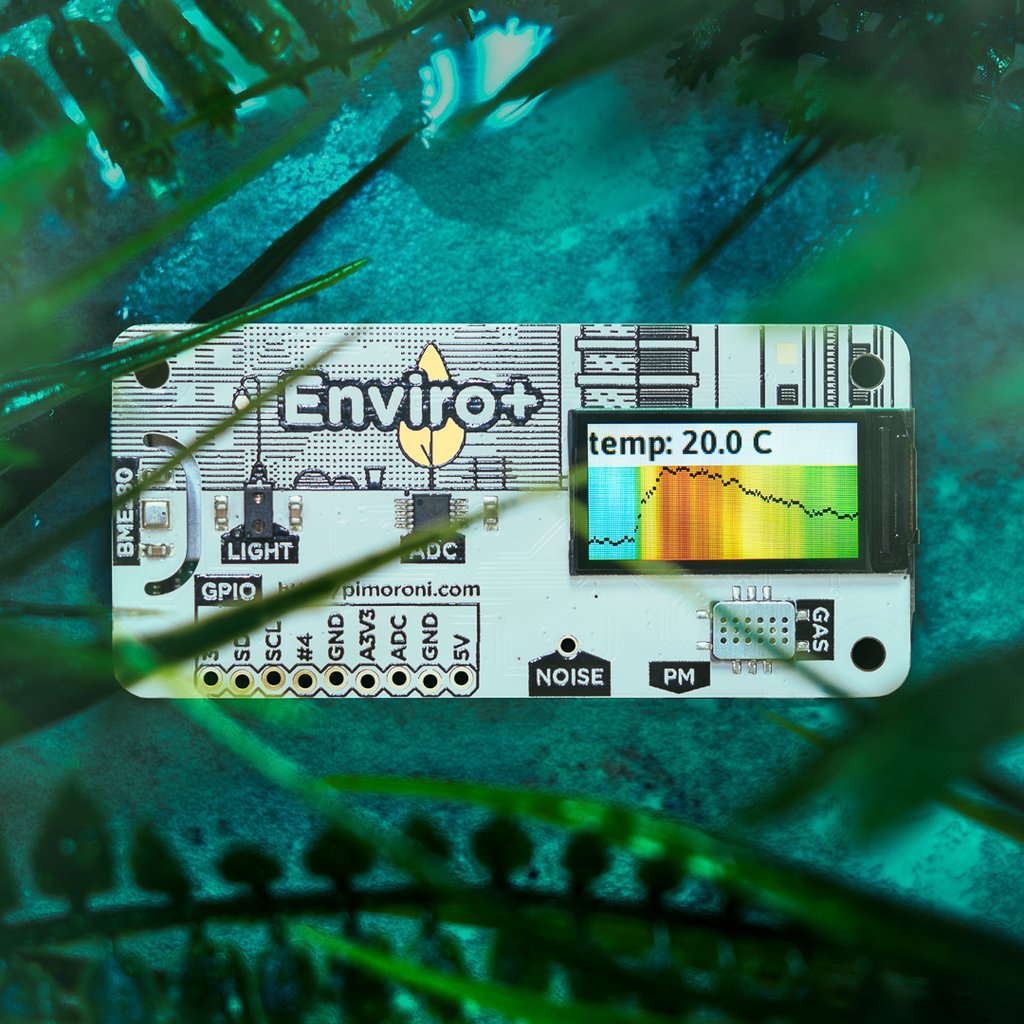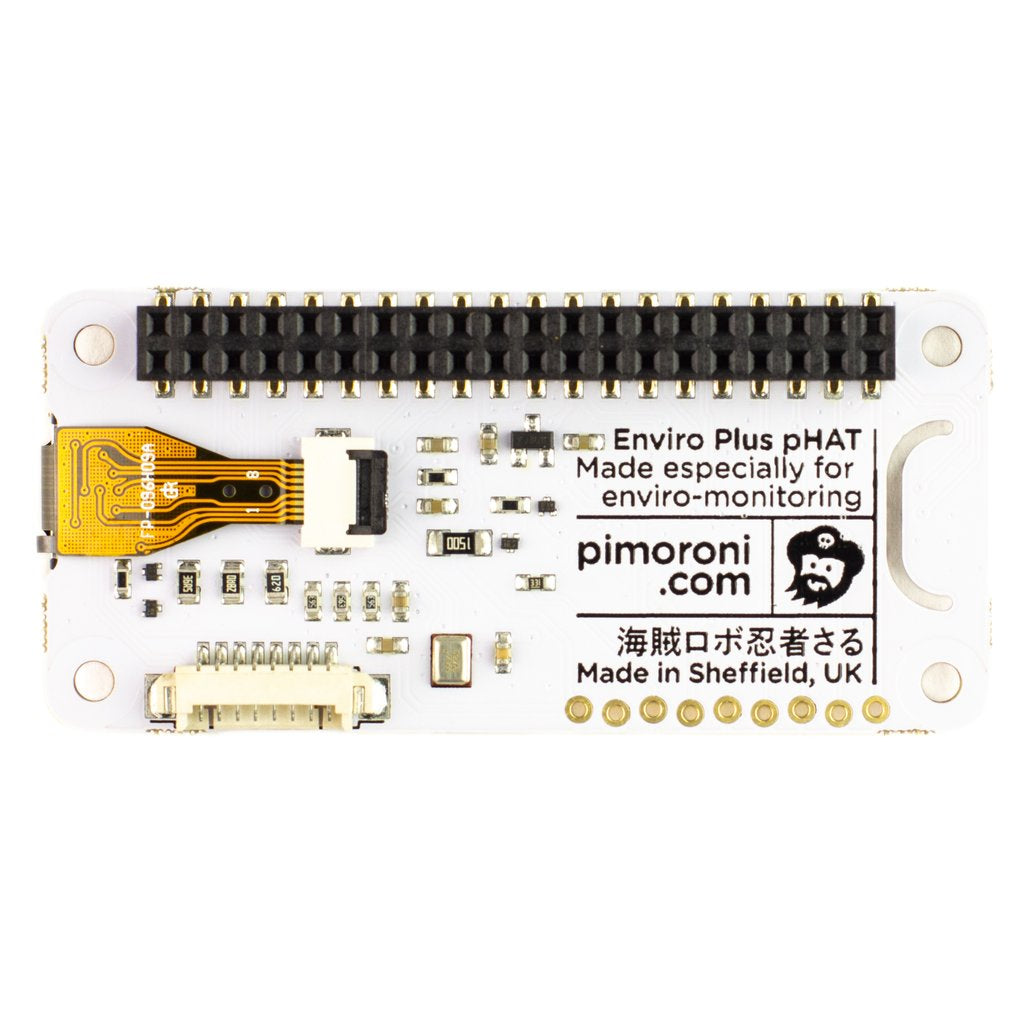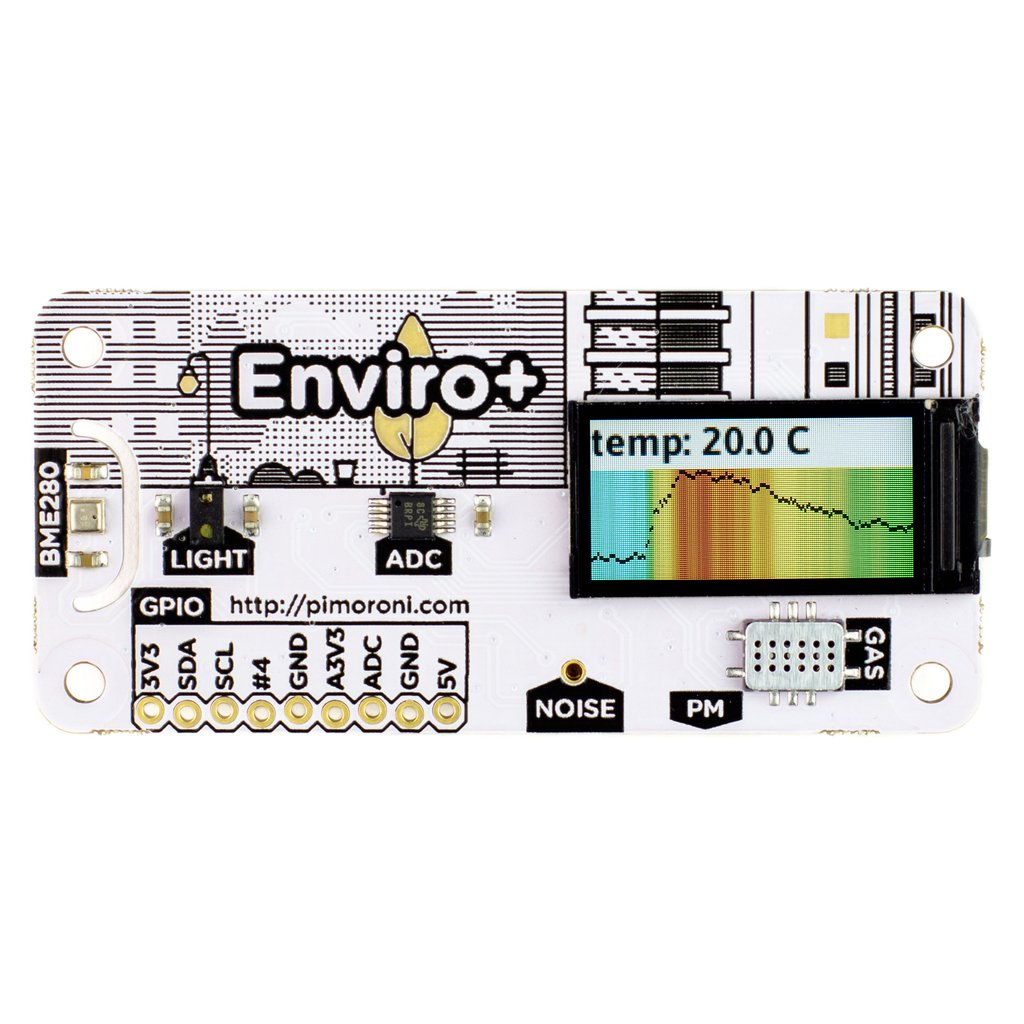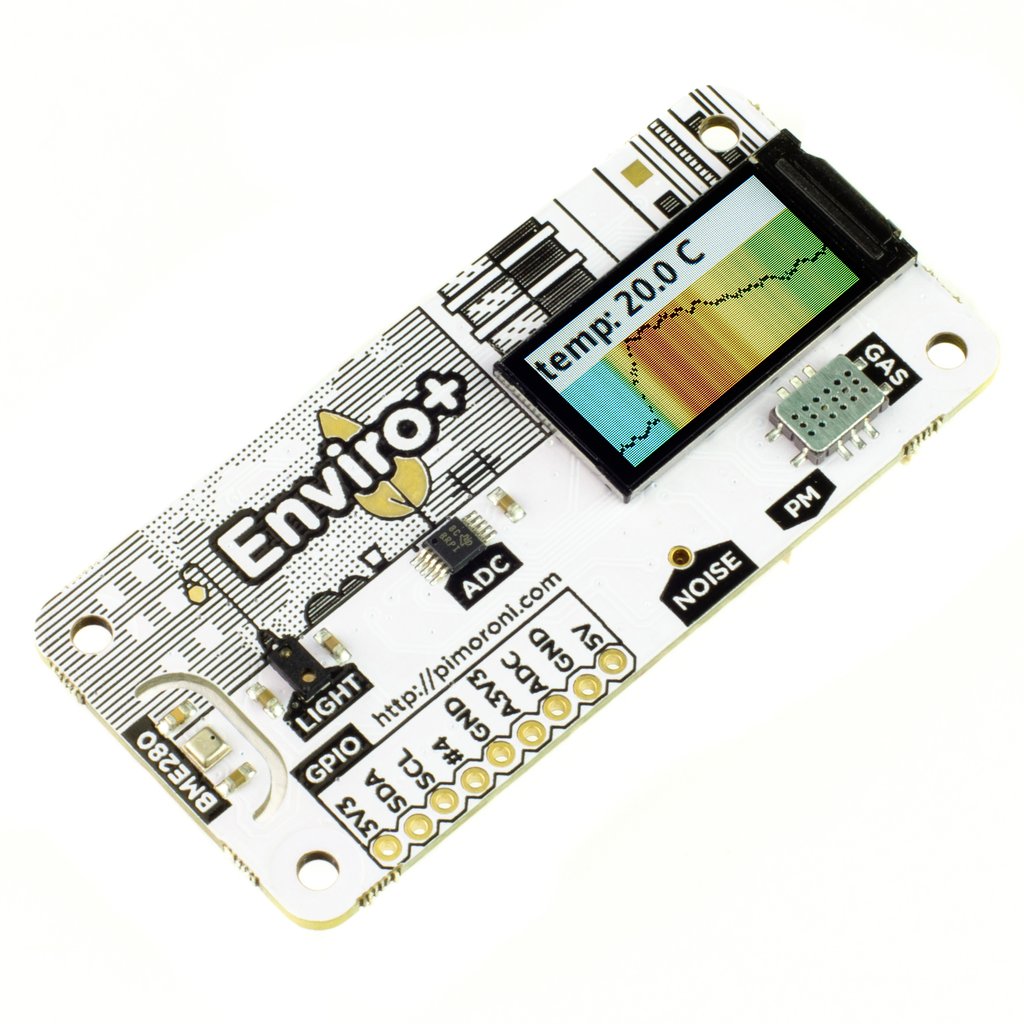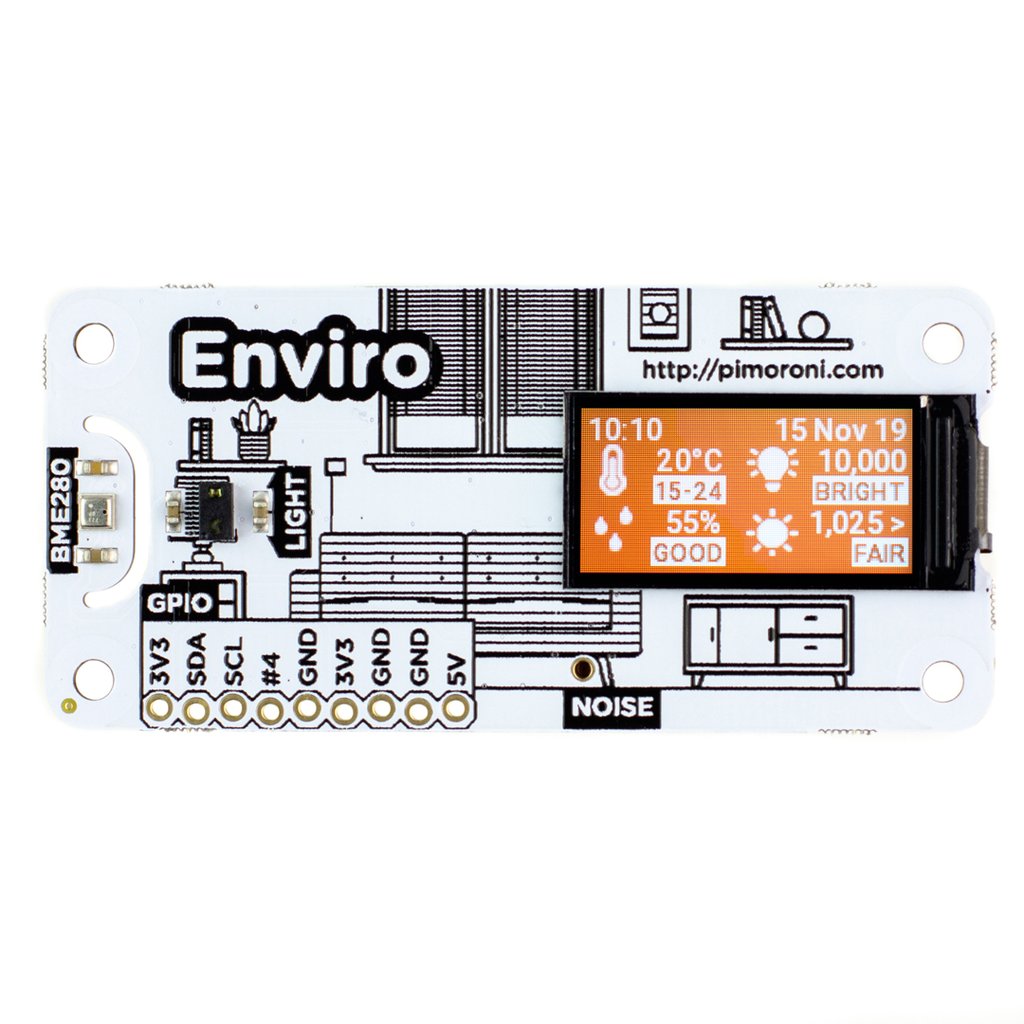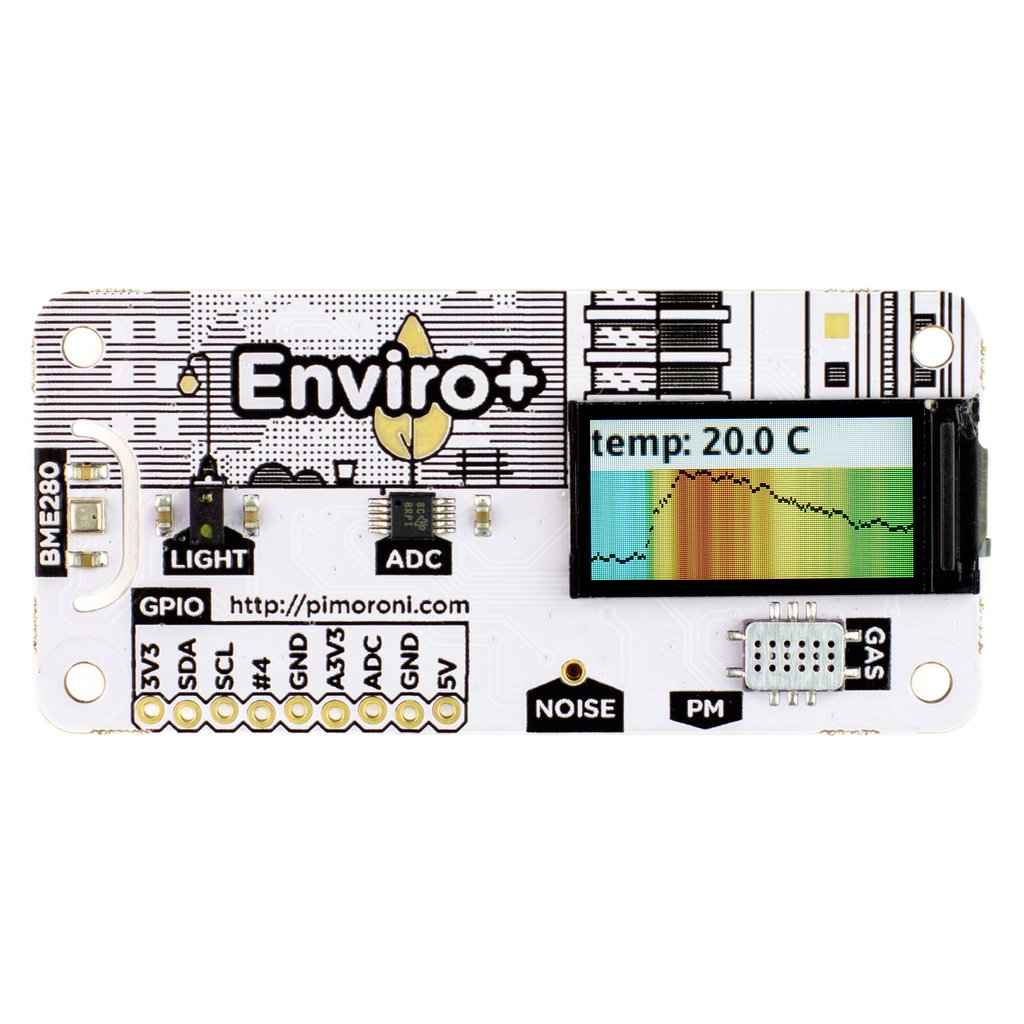Ein Produkt von Pimoroni - in einer Standard (Enviro) und einer erweiterten Version (Enviro+).
In beiden Fällen ein erweitertes HAT das noch viel mehr Möglichkeiten als das enviro pHAT bietet!
Überwachen Sie Ihre Welt!
Enviro + Air Quality wurde für die Umweltüberwachung entwickelt und ermöglicht Ihnen die Messung von Luftqualität (Schadgase und Feinstaub*), Temperatur, Druck, Luftfeuchtigkeit, Licht und Lärmpegel. In Kombination mit einem Feinstaubsensor* eignet er sich hervorragend für die Überwachung der Luftqualität außerhalb Ihres Hauses (weitere Informationen unten) und ermöglicht es Ihnen, Ihre Daten zu Citizen-Science-Bemühungen zur Überwachung der Luftqualität über Projekte wie Luftdaten beizutragen.
Enviro wurde für die Überwachung von Innenräumen entwickelt und ermöglicht Ihnen die Messung von Temperatur, Druck, Luftfeuchtigkeit, Licht und Geräuschpegel. Es ist großartig, um zu beobachten, was in den Räumen in Ihrem Haus, Büro oder anderswo vor sich geht. Übertragen Sie die Daten auf einen Server und Sie können die Daten von überall aus einsehen.
Enviro + Air Quality Merkmale
-
BME280 Temperatur-, Druck- und Feuchtigkeitssensor (Datenblatt)
-
LTR-559 Licht- und Näherungssensor (Datenblatt)
-
MICS6814 analoger Gassensor (Datenblatt)
-
ADS1015 Analog-Digital-Wandler (ADC) (Datenblatt)
-
MEMS-Mikrofon (Datenblatt)
-
0,96"-Farb-LCD (160x80)
-
Anschluss für Feinstaubsensor (PM) (separat erhältlich)
-
Pimoroni-Breakout-kompatible Stiftleiste
-
Platine im pHAT-Format
-
Vollständig bestückt
-
Kompatibel mit allen Raspberry Pi-Modellen mit 40-poliger Stiftleiste
-
Abmessungen: 65x30x8,5mm
Enviro Merkmale
-
BME280 Temperatur-, Druck- und Feuchtigkeitssensor (Datenblatt)
-
LTR-559 Licht- und Näherungssensor (Datenblatt)
-
MEMS-Mikrofon (Datenblatt)
-
0,96" Farb-LCD (160x80)
-
Pimoroni-Breakout-kompatible Stiftleiste
-
Platine im pHAT-Format
-
Vollständig bestückt
-
Kompatibel mit allen Raspberry Pi-Modellen mit 40-poliger Stiftleiste
-
Abmessungen: 65x30x8,5mm
Der alarmierende Rückgang unserer Luftqualität ist etwas, das wirklich wichtig zu verstehen ist. Geräte wie Enviro + Air Quality ermöglichen feinkörnige, detaillierte Datensätze, die es uns ermöglichen, Veränderungen der Luftqualität im Laufe der Zeit und in verschiedenen Bereichen der Städte zu sehen. Je mehr Geräte Daten beisteuern, desto besser wird die Qualität des Datensatzes.
Feinstaub (PM) besteht aus winzigen Partikeln unterschiedlicher Größe und Art, wie Staub, Pollen, Schimmelsporen, Rauchpartikel, organische Partikel und Metallionen und mehr. Partikel sind ein Großteil dessen, was wir als Luftverschmutzung empfinden. Sie können in Größe und Menge von Feinstaubsensoren wie dem PMS5003 gemessen werden, den Sie an Enviro + Air Quality anschließen können.
Mit dem analogen Gassensor können Sie qualitative Messungen von Änderungen der Gaskonzentrationen vornehmen, so dass Sie grob sagen können, ob die drei Gasgruppen in ihrer Häufigkeit zu- oder abnehmen. Ohne Laborbedingungen oder Kalibrierung können Sie zum Beispiel nicht sagen: "Die Konzentration von Kohlenmonoxid beträgt n Teile pro Million".
Auch die Temperatur, der Luftdruck und die Luftfeuchtigkeit können sich auf die Partikelkonzentration (und die Messwerte des Gassensors) auswirken. Daher ist der BME280-Sensor des Enviro + Air Quality sehr wichtig für das Verständnis der anderen Daten, die er ausgibt.
Pimoroni hat eine Anleitung, die Ihnen zeigt, wie Sie Enviro + Air Quality verwenden und ein paar leicht erhältliche Bits, um das Board in ein wetterfestes Gehäuse zu bauen, das Sie außerhalb Ihres Hauses montieren können, um die lokale Luftqualität zu überwachen.
Innenraumüberwachung mit Enviro
Enviro ist speziell für die Überwachung von Innenräumen konzipiert. Die Messwerte für Temperatur, Luftfeuchtigkeit, Licht und Lärm können verwendet werden, um die Bedingungen in Ihrem Haus zu überwachen. In Kombination mit dem LCD zur Anzeige der Daten und dem Näherungssensor für die Interaktion ist es ein ideales Headless-Überwachungsgerät.
Warum kombinieren Sie es nicht mit einigen IoT-Smarts wie einem Alexa-Skill, damit Sie nach der Temperatur oder Luftfeuchtigkeit fragen können? Oder Sie könnten eine Trigger-Aktion mit IFTTT einrichten, die Ihre Philips Hue-Leuchten einschaltet, wenn die Lichtstärke unter einen bestimmten Wert fällt. Es gibt eine Menge Möglichkeiten!
Software
Pimoroni hat eine Python-Bibliothek zusammengestellt, um alle Teile Ihres Enviro und Enviro + Air Quality zu steuern. Es gibt eine Reihe von Beispielen für jedes der einzelnen Teile, allesamt Beispiele, die Ihnen die Daten der Sensoren auf visuelle Weise zeigen. Es gibt auch ein Beispiel, das Ihnen zeigt, wie Sie Daten zu Luftdaten beitragen können (erfordert Enviro + Air Quality und Feinstaubsensor).
Erste Schritte
Lesen Sie sich unser (ausführliches!) Tutorial "Erste Schritte mit Enviro+" durch, das Ihnen zeigt, wie Sie die Software installieren, die Codebeispiele ausführen und die Python-Bibliothek verwenden.
English Description
Monitor your world with Enviro and Enviro + Air Quality for Raspberry Pi! There's a whole bunch of fancy environmental sensors on these boards, and a gorgeous little full-colour LCD to display your data. They're the perfect way to get started with citizen science and environmental monitoring!
Monitor your world!
Enviro + Air Quality is designed for environmental monitoring, and lets you measure air quality (pollutant gases and particulates*), temperature, pressure, humidity, light, and noise level. When combined with a particulate matter sensor*, it's great for monitoring air quality just outside your house (more information below) and lets you contribute your data to citizen science efforts to monitor air quality via projects like Luftdaten.
Enviro is designed for indoor monitoring, letting you measure temperature, pressure, humidity, light, and noise level. It's great for keeping tabs on what's going on in rooms in your house, office, or elsewhere. Push the data to server and you can view the data remotely from anywhere.
Enviro + Air Quality features
- BME280 temperature, pressure, humidity sensor (datasheet)
- LTR-559 light and proximity sensor (datasheet)
- MICS6814 analog gas sensor (datasheet)
- ADS1015 analog to digital converter (ADC) (datasheet)
- MEMS microphone (datasheet)
- 0.96" colour LCD (160x80)
- Connector for particulate matter (PM) sensor (available separately)
- Pimoroni breakout-compatible pin header
- pHAT-format board
- Fully-assembled
- Compatible with all 40-pin header Raspberry Pi models
- Pinout
- Python library
- Dimensions: 65x30x8.5mm
Enviro features
- BME280 temperature, pressure, humidity sensor (datasheet)
- LTR-559 light and proximity sensor (datasheet)
- MEMS microphone (datasheet)
- 0.96" colour LCD (160x80)
- Pimoroni breakout-compatible pin header
- pHAT-format board
- Fully-assembled
- Compatible with all 40-pin header Raspberry Pi models
- Python library
- Dimensions: 65x30x8.5mm
Citizen science with Enviro + Air Quality
Pimoroni has developed Enviro + Air Quality in collaboration with the University of Sheffield, with the aim of letting you contribute real-time air quality data from your local area to open data projects like Luftdaten.
The alarming drop in our air quality is something that's really important to understand. Devices like Enviro + Air Quality allow fine-grained, detailed datasets that let us see shifts in air quality through time and across different areas of cities. The more devices that contribute data, the better quality the dataset becomes.
Particulate matter (PM) is made up of tiny particles that are a mix of sizes and types, like dust, pollen, mould spores, smoke particles, organic particles and metal ions, and more. Particulates are much of what we think of as air pollution. They can be measured, in size and quantity, by particulate matter sensors like the PMS5003 that you can connect to Enviro + Air Quality.
The analog gas sensor can be used to make qualitative measurements of changes in gas concentrations, so you can tell broadly if the three groups of gases are increasing or decreasing in abundance. Without laboratory conditions or calibration, you won't be able to say "the concentration of carbon monoxide is n parts per million", for example.
Temperature, air pressure and humidity can all affect particulate levels (and the gas sensor readings) too, so the BME280 sensor on Enviro + Air Quality is really important to understanding the other data that it outputs.
Pimoroni has a tutorial that shows you how to use Enviro + Air Quality and a few easily-available bits to build the board into a weather-proof housing that you can mount outside your house to monitor local air quality.
Indoor monitoring with Enviro
Enviro is designed especially for indoor monitoring. The temperature, humidity, light, and noise readings can be used to keep track of conditions in your home and, combined with the LCD to display the data and the proximity sensor for interaction, it makes an ideal headless monitoring device.
Why not combine it with some IoT smarts like an Alexa skill so that you can ask what the temperature or humidity is? Or you could set up a trigger action with IFTTT that turns your Philips Hue lights on when the light level drops below a certain level. There's loads of possibilities!
Software
Pimoroni has put together a Python library to control all the parts of your Enviro and Enviro + Air Quality. There's a bunch of examples for each of the individual parts, all-in-one examples that shows you the data from the sensors in a visual way. There's also an example that shows you how to contribute data to Luftdaten (requires Enviro + Air Quality and particulate matter sensor).
Getting started
Have a read through our (exhaustive!) Getting Started with Enviro+ tutorial that walks you through how to install the software, how to run the code examples, and how to use the Python library.
Sicherheitsangaben
- Lesen Sie die Bedienungsanleitung sorgfältig durch, bevor Sie das Produkt verwenden.
- Stellen Sie sicher, dass alle Montage- und Installationsanweisungen des Herstellers sorgfältig befolgt werden.
- Verwenden Sie das Produkt nur für den vorgesehenen Zweck.
- Die unsachgemäße Nutzung dieses Produkts kann zu schweren Verletzungen oder Sachschäden führen.
- Nicht für Kinder unter 10 Jahren geeignet.
- Bei unsachgemäßer Verwendung besteht eine Verletzungsgefahr.
- Dieses Produkt entspricht den geltenden Sicherheitsanforderungen der Europäischen Union.
- Dieses Produkt wurde gemäß der GPSR geprüft, die sicherstellt, dass alle relevanten Sicherheitsanforderungen für Konsumgüter eingehalten werden.
Nachverfolgbarkeitsinformationen
Jedes Produkt verfügt über eines oder mehrere der folgenden Merkmale:
- Ein CE-Kennzeichen, das die Einhaltung der Sicherheits-, Gesundheits- und Umweltschutzanforderungen der Europäischen Union anzeigt.
- Eine eindeutige Serien- oder Chargennummer, um die Nachverfolgbarkeit zu gewährleisten und bei Bedarf Rückrufaktionen zu unterstützen.
- Hersteller- und Importeurangaben für den Kundensupport und Sicherheitsanfragen.
Überwachung und Berichterstattung von Vorfällen
Für den unwahrscheinlichen Fall eines Produktproblems haben wir Verfahren implementiert, um:
- Kundenbeschwerden zeitnah bearbeiten.
- Schwerwiegende Vorfälle über das EU Safety Gate/RAPEX-System melden.
- Mit den Marktüberwachungsbehörden zusammenarbeiten, um die öffentliche Sicherheit zu gewährleisten.
Kontakt:
- Email: support [@] pi3g.com
- Telefon: 0341 / 392 858 40
Dieses Produkt ist vollständig mit allen geltenden EU-Vorschriften konform, um die Sicherheit unserer geschätzten Kunden zu gewährleisten.

